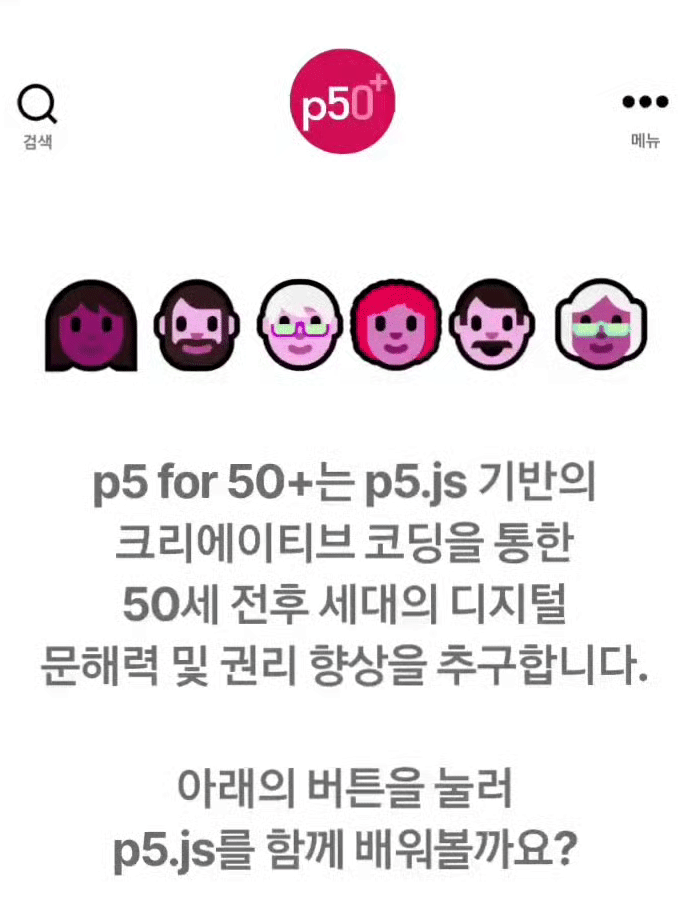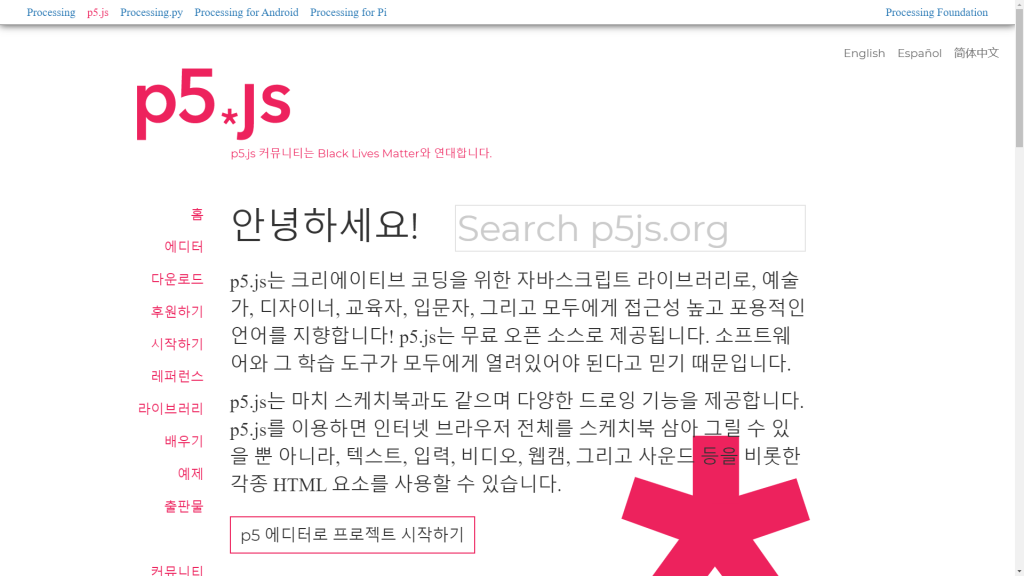CO-PROJECT LEAD with Seonghyeon Kim
MENTOR : Qianqian Ye / ADVISOR : Lauren McCarthy
SUPPORTED BY Processing Foundation
PROJECT WEBSITE https://p5for50.plus/
The major goal of our project p5 for 50+ was to contribute in enhancing the 50+ generations’ physical, emotional, and lingual accessibility to coding education — with p5.js! Basically, we aimed to address the issues of digital gap and illiteracy that people around age 50 face in a non-English-speaking society, South Korea. To this end, we have concretized our fellowship program with four different yet closely-connected outcomes:
1. https://p5for50.plus as Project Archives

We would like to introduce our project website https://p5for50.plus/ where we integrated our research archives and resources for learning p5.js and more.Through this website, we hope to better connect with p5 for 50+ web app users, workshop participants, and those who are interested in p5 for 50+ education. [We owe much of this website to our mentor Qianqian Ye, who had constantly emphasized the importance of archiving the project online so that we can share and open to future discussion. In her 2019 Processing Foundation Fellowship project, she published and archived in various social media platforms her online learning materials for non-English-speaking womxn. And one of her very first learners was her mother (who is assumably a 50+ person). Apparently, we had lot to learn from, relate and share with Qianqian.]
We started building our website in the first few months of fellowship program. During the time, we were having weekly seminars to define the needs and pain points in coding education from the perspective of 50+ population in South Korea. The research encompasses the statistics on their digital literacy, capability, and education opportunities; their difficulties with digital interfaces and interactions; the status quo of formal and informal programming education in Korea; the history of digitization and computer education in Korea; a worldwide need of the age group’s need in learning computer programming, etc. The findings are archived in 리서치 Research page of our project website.
In terms of our preliminary user research, Qianqian recommended us to open a 포럼 Forum page on our project website. We collected comments from people around us, such as our parents (50’s-60’s), friends and acquaintances (mainly in their mid-20’s to early 40’s). Although not necessarily from 50+ age group, most of them were unfamiliar to coding themselves, and shared their opinion on some issues as motivation for or challenges in learning coding as first-timers. We received 00 comments from n people in total, with answers to average 00 questions per topic questions.
In documenting the age group’s actual voice and insight, we interviewed 13 people (average age: 62.5) from Daejeon, contacted via a local welfare center, to find out their interests in p5 for 50+ workshops. What we would love to share with our readers here is, contrary to a common belief, the elderly interviewees demonstrated a high interest in “learning new technology” and “outdoor activities where they can socialize with others who share similar challenges.” This has much ascertained the possibility of p5 for 50+ project to us.
2. Prototype a low-barrier learning interface for 50+

From our researches, we discovered a strong need for a learning interface specially designed for the 50+. The key idea here is to offer a web app that is both physically and emotionally accessible for the first-timers of this age group; that brings interests to and sustains self-learning on p5.js during and after in-person workshop — or, maybe without the workshop in this “untact” era.
In particular consideration of “high confidence in using a smartphone than desktop PCs or laptops” that our interviewees have demonstrated, we wanted to create a mobile-based web app. We expected that they access p5.js materials and editor simply through a single URL on their smartphones — anytime and anywhere they want — without the burden of carrying around a laptop/tablet, or downloading an app on the phone.
So, this web-browser-based application (the prototype of which you can access on the very first page of https://p5for50.plus/ ) is like a simplified version of https://p5js.org/ko. We kept the structure and design elements of p5js.org — but, with less texts and bigger fonts, more visual elements and interactions coming to the front, and more focus on the basic concepts of computer programming, and with an easier use flow.
The learning materials in “Learn” section of our web app are mostly recapped from “Get Started”, “Reference”, “Examples”, “Learn” pages of the official website, and those original pages are re-introduced as “advanced information” through hyperlinks. And yet, we tried adjust the level of the “Learn” materials on the web app even easier than “Get Started” on p5js.org.
Furthermore, we embedded p5.js web editor so that the learners can practice coding, customize example codes, save and manage their codes — without a seperate or refreshed window. The users can also easily move back and forth the editor, guideline to editor, “Reference” (as in EN-KR function/method dictionary), or other menus while keeping their codes being written on the editor.
We consider p5 for 50+ web app as a stepping stone towards p5js.org/ko that can boost the age group’s confidence in (self-)learning through smartphones. We are hoping that the users feel at ease and fun in exploring the web app and then eventually move on to p5js.org through hyperlinks for in-depth knowledge — without being overwhelmed by the depth of it at first sight. Mentioning “overwhelmed” here, we want to recall our past experience as a first-timer, where we had to spend quite a time just to understand a single term “library” in the context of computer programming. We might have weathered through those ‘illiterate’ moments thanks to our digital capability, but some people need to secure more confidence in keep challenging themselves.
For a practical usage of web app not only for our upcoming workshop, but also for anyone needed, we are working towards September for the optimization and adding more examples.
3. p5 for 50+ Workshop Plans

The project website and web app were concretized over the course of planning our in-person p5 for 50+ workshop with our mentor Qianqian. What we particularly appreciate about her mentorship is that we could plan the workshop in consideration of what Qianqian led us to ponder on: the (re-)engagement in the workshop and its sustainability. We remember when she quoted from our advisor Lauren McCarthy’s webinar “You, Me and My Computer” that: “teaching coding sometimes is about not loosing people, …, it is about how to keep them engaged instead of scaring them out.” Qianqian’s also shared some p5.js workshop cases, including her own, all of which helped us a lot in seeking ways to “keep the 50+ engaged”. Combining the insight from our weekly mentor meetings, discussion, and researches, we could devise some principles for designing our p5 for 50+ workshop curriculum
The quantitative and qualitative evaluation on this web app is to be conducted in our upcoming p5 for 50+ workshop at Asia Culture Center in Gwangju (expected in week 1-2 of August, but the schedule is subject to change due to the COVID-19). Based on this workshop, we hope developing coding education curriculum and interfaces for middle-aged and elderly people in the future.
4. Korean translation of the p5.js website

All of our works above would have been impossible without the Korean translation of p5js.org ( was the foundation of our project.) The issue of enhancing the accessibility of the Korean 50+ people to p5.js could only start from this translation. It is important to note that English comes as a double-bind for non-Anglophones when learning coding, since codes are written in English and most of the learning materials and online forum circulate in English.
The translation is dedicated to the entire Korean-speaking population around the world. We hope to have more language groups engage with p5 in further accessible and legible manners. For more information on the translation process, please refer to this Medium post and the program glossary
